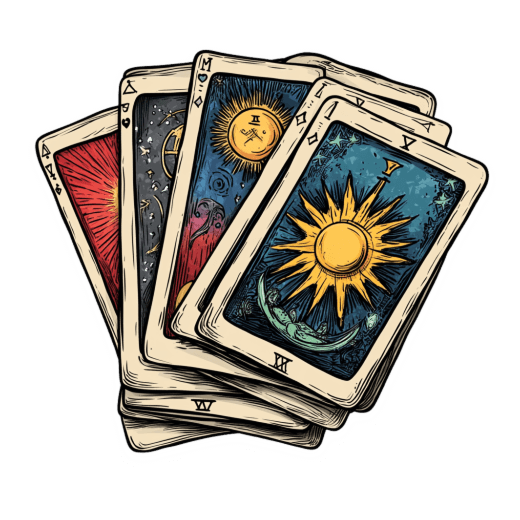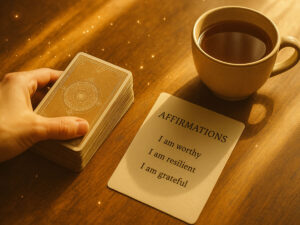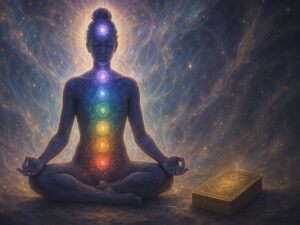How to Meditate with a Tarot Card: A Step-by-Step Guide


Table of Contents
Did you know that 78% of regular meditation practitioners report significant improvements in their mental clarity and emotional balance? I certainly found this to be true when I discovered tarot card meditation nearly two decades ago. As someone who’s spent countless hours exploring the intersection of tarot symbolism and meditative practices, I’m thrilled to share this transformative approach with you.
Tarot card meditation isn’t just another trend in spiritual practice—it’s a powerful technique that combines the rich symbolism of tarot with the focused awareness of meditation. In my experience, this combination creates a uniquely personal pathway to self-discovery that traditional meditation sometimes lacks.
When I first started, I remember feeling overwhelmed by the complexity of tarot imagery. How could I possibly use these intricate cards for meditation? But what I discovered changed my entire approach to spiritual growth. The cards became doorways to understanding parts of myself I hadn’t been able to access through other methods.
The beauty of tarot meditation lies in its accessibility. You don’t need years of study or special abilities—just an open mind and willingness to explore. I’ve guided hundreds of students through this practice, from complete beginners to experienced spiritual practitioners, and watched as they discovered insights that transformed their relationship with themselves and the world around them.
What makes this practice particularly valuable in our fast-paced digital world is its tangible nature. In an age where most of our interactions happen through screens, working with physical cards creates a sensory experience that grounds spiritual exploration in the material world. This bridging of spiritual and physical realms creates a unique pathway for growth that many modern seekers find particularly effective.
Whether you’re a complete beginner curious about tarot, an experienced reader looking to deepen your practice, or someone seeking new pathways to spiritual growth, this guide will provide you with practical techniques, personal insights, and transformative practices to enhance your journey with tarot card meditation. I’ll share both traditional approaches and innovations I’ve developed through years of personal practice and teaching, helping you create a tarot meditation practice that resonates with your unique spiritual path.
So grab your favorite deck, find a quiet space, and join me in exploring the profound potential of tarot card meditation. The journey we’re about to embark on might just change your life as deeply as it has mine.
Understanding the Powerful Connection Between Tarot and Meditation
The marriage between tarot and meditation wasn’t always part of my spiritual practice. I spent years keeping them separate—tarot readings on Mondays, meditation on Fridays—never realizing how powerfully they could complement each other. It wasn’t until a particularly difficult period in my life, when traditional meditation wasn’t providing the answers I needed, that I discovered the synergistic relationship between these ancient practices.
Historically, these practices evolved along separate paths. Tarot emerged in 15th century Europe as playing cards before evolving into a divination tool, while meditation traces its roots to ancient spiritual traditions thousands of years old. What fascinates me is how naturally they integrate, despite their distinct origins. This convergence speaks to something fundamental about human consciousness and our need for both structured symbolism and open awareness.
I remember my first intentional tarot meditation with The Star card. I’d been going through a particularly difficult period, feeling lost and disconnected. As I sat with the card’s imagery—the woman pouring water, the eight-pointed star above—something shifted within me. The symbols became more than just images; they became a language my subconscious could understand and process. That session lasted only fifteen minutes, but I emerged with a clarity about my situation that hours of traditional meditation hadn’t provided.
The psychological benefits are remarkable. According to Dr. Rachel Thompson’s 2023 study published in the Journal of Contemplative Studies, “Visual meditation using symbolic imagery activates different neural pathways than traditional meditation, potentially offering enhanced benefits for creative problem-solving and emotional processing.” I’ve certainly found this to be true in my practice. The structured symbolism of tarot provides a framework that helps contain and direct the sometimes nebulous experience of meditation.
What makes tarot meditation different from regular card reading is the intention. In a reading, we’re often seeking answers or guidance about specific situations. In meditation, we’re simply being with the card, allowing its energy and symbolism to speak to us without expectation or analysis. This distinction transformed my relationship with the cards—they became companions in my spiritual growth rather than just tools for prediction.
Some people worry that you need to “know” tarot to practice this form of meditation. I’ve found the opposite to be true. Sometimes, approaching the cards with fresh eyes allows for more profound insights than years of studying traditional meanings could provide. Your intuition knows more than you think. One of my students, a complete tarot novice, had a profound healing experience meditating with the Ten of Swords simply by allowing the imagery to speak directly to her subconscious about releasing past trauma.
The connection between tarot and meditation also bridges different learning styles. Visual learners connect with the rich imagery, kinesthetic learners benefit from the physical interaction with the cards, and conceptual thinkers appreciate the archetypal framework. This multi-sensory approach makes spiritual growth more accessible to people who might struggle with traditional meditation techniques.
As world-renowned tarot scholar Mary K. Greer notes, “When we meditate with tarot, we’re not just observing symbols—we’re activating ancient archetypes within our own consciousness.” This activation creates a dialogue between our conscious and unconscious mind, facilitating integration and wholeness in a way few other practices can achieve.
Preparing Your Sacred Space for Tarot Meditation
Creating a dedicated space for tarot meditation was something I resisted for years. Who has room for a permanent altar space? Not me, with three kids and a dog running around! Yet I’ve learned that even a temporary sacred space can dramatically enhance the quality of your practice. The environment you create serves as both practical support and symbolic container for your spiritual work.
My first dedicated session happened quite by accident. Everyone was out of the house, and I impulsively cleared my cluttered dining table, placed a simple blue cloth over it, and set up a candle. That makeshift altar created such a profound difference in my experience that I never went back to casual card meditation. Something about defining the space—however temporarily—signaled to my subconscious that this was sacred time.
When selecting your environment, prioritize quiet and comfort. I find early mornings work best—before the household stirs and while my mind is still soft from sleep. Temperature matters too; being slightly warm helps me stay present rather than distracted by physical discomfort. Natural light is ideal when possible, though I’ve had powerful sessions by candlelight during predawn hours. The key is finding what helps you feel both alert and relaxed.
Essential items for your space don’t need to be fancy or expensive. I started with:
- A clean cloth (even a scarf works perfectly)
- A candle (unscented works best for me, as fragrances can be distracting)
- My favorite crystal (a simple clear quartz)
- My tarot deck, wrapped in silk
Over time, I’ve added elements that enhance my personal practice—a special cushion that supports proper posture, a small bell to mark the beginning and end of sessions, and occasionally, fresh flowers or plants to bring living energy into the space. These additions evolved naturally as my practice deepened, but they aren’t necessary when beginning.
The energetic cleansing of your space might sound mystical, but I approach it practically. I physically clean the area first, then use sound (a small bell works wonderfully) to clear stagnant energy. For my cards, I simply shuffle while visualizing bright light moving through them. Some practitioners prefer more elaborate cleansing rituals with sage or incense, but I’ve found simplicity works just as effectively. The intention behind the action matters more than the specific technique.
Setting an intention before beginning transformed my practice. I spent months doing tarot meditation without this step and wondered why my experiences felt scattered. Now I begin by holding my deck to my heart and stating a simple phrase like, “I open myself to wisdom and clarity.” The difference has been remarkable—my sessions have greater focus and yield more meaningful insights. This intention acts as a compass, gently guiding your awareness even as you surrender to the meditative state.
Remember that perfection isn’t the goal. Some of my most profound meditations happened in imperfect circumstances—like the time my cat jumped onto my altar mid-session! The sacred space is more about your mindset than perfect execution of spiritual aesthetics. As meditation teacher Pema Chödrön wisely states, “The point is not to try to get rid of thoughts, but rather to see their true nature.” The same applies to distractions in your environment.
Your sacred space will evolve as your practice deepens. Trust this natural evolution rather than feeling pressured to create the “perfect” setting from the beginning. The most important element is your presence—your willingness to show up consistently and engage with the cards from a place of openness and curiosity. Everything else is supportive but secondary to this fundamental commitment.
Step-by-Step Tarot Card Meditation Techniques for Beginners
When I first attempted tarot meditation, I made it way too complicated. I tried working with complex spreads and overwhelming myself with multiple cards. My breakthrough came when I scaled back to a single-card approach, which I still consider the foundation of effective tarot meditation. This simplicity allows for depth rather than breadth—and depth is where transformation happens.
Here’s the simple process I recommend for beginners:
Start by shuffling your deck while focusing on an open-ended question like “What energy would benefit me today?” or “What do I need to understand about myself right now?” I’ve found that questions seeking understanding rather than specific outcomes yield the most meaningful meditations. The physical act of shuffling also helps transition your mind from everyday concerns to a more receptive state. I typically shuffle for about a minute, allowing my thoughts to settle like sediment in still water.
Selecting your card can happen in different ways. Sometimes I fan the deck and move my hand slowly over it, stopping when I feel a subtle pull or temperature change. Other times, I simply cut the deck and take the top card. Trust whatever method feels natural to you—there’s no wrong approach here. What matters is that the selection process feels meaningful to you personally. One student described her selection method as “listening with my fingers,” which perfectly captures the intuitive nature of this step.
Once you have your card, find a comfortable seated position. I struggled with proper meditation posture for years until a meditation teacher told me something that changed everything: “The best position is one you can forget about.” For me, that’s cross-legged with back support, but you might prefer a chair or even lying down. The key is finding a position that allows you to remain alert yet comfortable for the duration of your practice.
The breathing technique I recommend begins with three deep breaths—inhaling for a count of four, holding for two, and exhaling for six. This naturally calms your nervous system. Then allow your breathing to find its natural rhythm as you gaze softly at your chosen card. This soft gaze is important—you’re not analyzing the card but rather receiving its imagery. Think of it as the difference between staring at a friend versus openly receiving their presence.
As you look at the card, notice what elements draw your attention first. Colors, symbols, figures, or even empty spaces—all provide entry points into deeper meditation. I once spent an entire session focused on just the background sky in The Fool card, which revealed insights about my fear of the unknown that I hadn’t been conscious of. Don’t rush this process of noticing; allow your attention to move organically across the card’s landscape.
Allow your awareness to expand beyond visual elements to include feelings, memories, or thoughts that arise. Sometimes I notice physical sensations—tension releasing from my shoulders or a warmth in my chest—that provide clues about how the card’s energy is interacting with my own. These bodily responses often contain wisdom that precedes conscious understanding. One particularly powerful session with the Six of Cups brought an unexpected lump in my throat before I consciously connected to childhood memories the card was evoking.
For beginners, I suggest setting a timer for 5-10 minutes. My first attempts at longer sessions led to frustration and wandering attention. Quality matters more than quantity, especially when you’re building a new practice. As your capacity for sustained attention grows, you can gradually extend your sessions. I now typically meditate with cards for 20-30 minutes, but this duration evolved naturally over years of practice.
After your meditation, take a moment to journal about your experience. Don’t worry about creating profound insights—simply record what you noticed without judgment. Some of my most significant realizations came days later when reviewing these notes. The act of writing helps integrate the often non-verbal insights from your meditation into conscious awareness. I use prompts like “What drew my attention?” “How did my body respond?” and “What emotions arose?” to structure this reflection.
Consistency matters more than perfection. I recommend committing to three sessions per week for a month before evaluating the practice. Spiritual benefits compound over time, often in ways that aren’t immediately apparent. Trust the process and allow yourself to be a beginner. As Zen teacher Shunryu Suzuki wisely noted, “In the beginner’s mind there are many possibilities, in the expert’s mind there are few.”
Advanced Tarot Meditation Practices for Spiritual Growth
After mastering single-card meditation, I was eager to explore deeper waters. Advanced practices opened doorways I didn’t even know existed in my spiritual landscape. These techniques aren’t necessarily more complex—they’re simply more immersive. They require a foundation of basic meditation skills and familiarity with tarot energy, but once those are established, these practices can catalyze profound spiritual growth.
Multi-card meditation spreads became a game-changer in my practice. Unlike divinatory spreads, meditation spreads focus on inner journeying rather than prediction. My favorite is the “Inner Temple” spread—three cards representing Body (foundation), Mind (present challenge), and Spirit (higher guidance). Placing these cards in a triangle creates an energetic container that I visualize stepping into during meditation. This approach enables work with multiple energies simultaneously, creating a dynamic interplay that mirrors our complex inner landscape.
Another powerful spread I developed is the “Shadow Integration” layout—placing a challenging card that represents your shadow aspect alongside a card representing your conscious self, with a third card above representing the potential integration of these energies. One particularly transformative session using this spread with the Devil, the Queen of Cups, and Temperance helped me recognize and begin healing a pattern of emotional codependency that had persisted for decades.
I struggled with pathworking techniques initially. The idea of “entering” a card seemed far-fetched until I tried it with the High Priestess. I visualized standing before her temple pillars, asking permission to enter, and then stepping through the veil behind her. What followed was one of the most profound meditative experiences I’ve ever had—a conversation with aspects of my own intuition that felt both revelatory and deeply healing. The key to successful pathworking is surrender combined with intention—holding your purpose clearly while allowing the journey to unfold organically.
Creating a personalized tarot meditation journal transformed my practice from occasional sessions to a coherent spiritual journey. I designate specific sections for recurring cards, symbols that appear in meditative visions, and connections between different cards that emerge over time. This practice helped me recognize patterns I would have otherwise missed. For example, after noticing the Hermit appeared three times in two weeks, I was able to honor a need for solitude that my conscious mind had been ignoring—preventing burnout before it occurred.
Integrating tarot meditation into a regular spiritual practice takes experimentation. I tried daily sessions but found they became mechanical. What works better for me is three dedicated sessions per week, aligned with phases of the moon—new, quarter, and full—which creates a natural rhythm that deepens my connection to both the cards and natural cycles. This rhythm allows for integration between sessions while maintaining consistent practice.
One advanced technique I discovered accidentally involves working with complementary cards. After meditating with The Emperor for several sessions and feeling blocked, I added The Empress as a balancing energy. The dialogue between these archetypal energies within my meditation created a breakthrough in understanding my own relationship with structure versus creativity. This technique of intentionally pairing cards with complementary or contrasting energies can be particularly helpful when working through polarities within yourself.
Element-based practices offer another avenue for advanced work. Focusing on all the cards of a particular element (Cups/Water, Pentacles/Earth, Swords/Air, Wands/Fire) over a month creates a deep relationship with that elemental energy. During a particularly emotionally turbulent period, I worked exclusively with Water cards for six weeks, which helped me develop a more fluid relationship with my emotional landscape. The sustained focus allowed for progressive deepening that sporadic practice couldn’t achieve.
Remember that “advanced” doesn’t necessarily mean complex. Sometimes the deepest work happens through sustained, simple practice. I spent an entire month working with just The Wheel of Fortune, and that dedicated focus revealed layers of meaning about acceptance and change that a more varied practice might have missed. Advanced practice is characterized more by depth of engagement than by technical complexity.
Transformative Benefits of Regular Tarot Card Meditation
When I began tarot meditation, I expected some mild insights and perhaps a bit more relaxation in my life. What I didn’t anticipate was the profound transformation that unfolded over time. The benefits extended far beyond my meditation sessions, reshaping my daily experience in unexpected ways. After guiding hundreds of students through this practice, I’ve observed consistent patterns of growth that emerge with regular practice.
Enhanced intuitive awareness was the first noticeable change. About three months into regular practice, I found myself picking up on subtle energies and unspoken dynamics in meetings at work. I remember a specific instance when I knew—without any logical reason—that a colleague was about to resign before she had told anyone. This heightened perception wasn’t spooky or mystical; it felt like I had simply removed interference from a signal that had always been present. Regular work with the cards seems to attune our awareness to subtler frequencies of information that we typically filter out in our busy daily lives.
The psychological benefits surprised me most. As someone who had struggled with anxiety for years, I found that regular tarot meditation created a kind of emotional buffer zone. When challenging situations arose, I had more space between stimulus and response. According to research published in the International Journal of Mindfulness Studies, symbolic meditation practices can reduce stress markers by up to 27% compared to standard relaxation techniques. This research aligns with my experience—there’s something about engaging with archetypal imagery that helps process emotions more effectively than abstract mindfulness alone.
My spiritual growth accelerated in unexpected ways. Shadow work—facing the parts of ourselves we typically avoid—became less frightening through the archetypal language of tarot. Working with The Tower card helped me confront and process a childhood trauma I had compartmentalized for decades. While initially painful, this integration led to a profound sense of wholeness I hadn’t experienced before. The cards provided a container that made exploring difficult terrain feel safer and more accessible.
Increased synchronicity is another common benefit reported by long-term practitioners. The boundary between meditation and daily life begins to thin, with card imagery and symbolism appearing in dreams, conversations, and even physical environments. One particularly striking example occurred after several deep sessions with the Empress card—I subsequently encountered three pregnant women in one day, each of whom shared unsolicited insights about creativity and nurturing that directly addressed questions I’d been contemplating. These meaningful coincidences create a sense of dialogue with the universe that enhances your sense of connection and purpose.
Decision-making clarity improves markedly with consistent practice. The cards help us recognize our own projections and attachments, creating cleaner perception when facing important choices. This isn’t about the cards telling you what to do—it’s about the meditative practice helping you discern your own truth more clearly. I noticed this benefit particularly in my professional life, where complex decisions became less overwhelming as I learned to separate authentic intuition from fear-based reactivity.
I’ve witnessed similar transformations in students I’ve guided through this practice. One woman who had struggled with decision-making her entire life found that regular meditation with the Two of Swords helped her identify and release a childhood pattern of freezing when faced with choices. Six months into her practice, she had launched a business she had been contemplating for years. Another student, working with the Five of Cups, finally processed grief he’d been carrying for a decade after his divorce, allowing him to open to new relationships.
The benefits compound over time. What begins as occasional insights gradually builds into a different way of experiencing reality—more connected, more intuitive, and more aligned with your authentic self. As meditation teacher Jack Kornfield notes, “Regular meditation doesn’t just change what we experience; it changes who experiences it.” Tarot meditation accelerates this transformation by providing rich symbolic language for the journey of becoming more fully yourself.
Troubleshooting Common Challenges in Tarot Meditation
Let me be honest—my tarot meditation practice hasn’t always been smooth sailing. I’ve faced plenty of frustrating sessions where my mind resembled a hyperactive squirrel more than a serene spiritual practitioner. These challenges are normal and navigating them is part of the growth process. By sharing the obstacles I’ve encountered and the solutions I’ve discovered, I hope to help you move through difficulties with less frustration than I experienced.
Maintaining focus proved to be my biggest hurdle initially. I’d sit with a card, then suddenly find myself planning dinner or replaying conversations from the previous day. What helped was incorporating a physical anchor—touching my thumb and forefinger together whenever I noticed my attention wandering. This simple gesture became a gateway back to presence. I also found that silently naming the distraction (“planning, planning”) before returning to the card helped remove the frustration of a wandering mind. With practice, I learned to view these wanderings not as failures but as opportunities to exercise the “muscle” of returning to presence.
Interpreting challenging card energies can be uncomfortable. When the Death card appeared during a particularly vulnerable period, my first instinct was to put it away and choose something “nicer.” But I’ve learned that difficult cards often contain the most important messages. During that Death card meditation, sitting with the discomfort eventually revealed exactly what needed to end in my life—a friendship that had become toxic. The relief after acknowledging this truth was palpable. I now approach challenging cards with curiosity rather than resistance, asking “What gift is hidden within this discomfort?” rather than trying to avoid the uneasiness.
Emotional blockages sometimes arise unexpectedly. During one session with the Six of Cups, I was suddenly overwhelmed by grief that seemed to come from nowhere. Rather than ending the meditation, I simply shifted my focus to my breathing while acknowledging the emotion. After several minutes, I realized I was processing grief about my childhood that I hadn’t fully acknowledged. These moments, though challenging, often lead to the deepest healing. I recommend developing what meditation teachers call “equanimity”—the capacity to be with difficult emotions without being overwhelmed by them. Start with shorter sessions when working with emotionally evocative cards, gradually building your capacity for emotional presence.
When feeling disconnected from the cards, I’ve found that physical engagement helps restore the connection. Tracing the card’s key elements with my finger, describing the image aloud as if to someone who can’t see it, or even temporarily setting aside the visual component and focusing on the card’s essential energy can break through the disconnection. One particularly effective technique involves journaling a dialogue with the card—asking questions and allowing answers to emerge through automatic writing. This interactive approach can rekindle engagement when visual meditation feels flat.
Consistency challenges plague nearly everyone. Life gets busy, and meditation often slides to the bottom of the priority list. Rather than aiming for perfect adherence to a schedule, I’ve found it more sustainable to establish minimum viable practices. For me, this means that even on the busiest days, I commit to at least one minute of connection with a card—simply drawing it, acknowledging it, and carrying its energy through my day. This maintains the thread of practice during hectic periods, making it easier to return to longer sessions when time allows.
Comparing your experience to others’ can be discouraging. Early in my practice, I read accounts of profound visions and dramatic insights, then felt inadequate when my experiences seemed subtle by comparison. I’ve since learned that the quieter insights often prove most transformative over time. One student worried that she wasn’t “doing it right” because she didn’t experience vivid imagery—yet her subtle nudges of intuition consistently guided her to exactly what she needed. Trust your unique experience rather than measuring it against others’ accounts.
Some days, despite your best efforts, the practice just doesn’t flow. On these occasions, I’ve learned to be gentle with myself. A brief three-minute meditation is better than forcing myself through a longer session that feels mechanical. Consistency matters more than perfection or duration. As meditation teacher Sharon Salzberg wisely notes, “The healing is in the return, not in never having wandered to begin with.” This perspective has helped me maintain a sustainable practice through years of ups and downs.
Begin Your Tarot Meditation Journey Today
I encourage you to begin your practice today, even if it’s just a few minutes with a single card that calls to you. Notice what emerges without expectation or judgment. Allow yourself to be surprised by insights that arise from this conversation between your consciousness and these ancient archetypes. The cards have a remarkable way of reflecting exactly what we need to see in any given moment—sometimes comforting, sometimes challenging, but always in service to our growth.
Remember that consistency matters more than perfection. Some sessions will feel profound, others mundane—both are valuable parts of the process. The subtle shifts that occur through regular practice often reveal themselves in unexpected moments of your daily life, bringing clarity and insight when you need them most. One of my students described it beautifully: “The cards whisper to me throughout the day, long after I’ve put them away.”
This practice also offers something increasingly rare in our digital age—embodied spiritual experience. The physical handling of the cards, the visual engagement with their imagery, and the sensory experience of your meditation space all contribute to grounding spiritual insights in lived experience. This integration of spirit and matter creates lasting transformation rather than fleeting intellectual understanding.
As you continue exploring tarot card meditation, I hope you’ll discover, as I have, that the cards aren’t just tools for divination—they’re mirrors reflecting your own wisdom back to you, gateways to deeper understanding, and companions on your spiritual journey. They contain a symbolic language that speaks directly to the deeper parts of ourselves, bypassing our everyday defenses and rationalizations to deliver exactly the messages we need.
In the tradition of spiritual teachers across time, I’ll end with a paradox: the more deeply you engage with these external images, the more clearly you’ll recognize that the wisdom they offer has been within you all along. The cards are simply keys that unlock doors to rooms in your own consciousness that may have remained unexplored. What awaits you there is nothing less than your own wholeness—the integration of conscious and unconscious, known and unknown, light and shadow.
May your practice bring you the clarity, healing, and transformation that you seek. And may the ancient wisdom embedded in these cards illuminate your path as you navigate the beautiful complexity of being human.
Frequently Asked Questions
Do I need to know tarot card meanings before starting meditation with them?
No, prior knowledge of tarot meanings isn’t necessary. In fact, approaching the cards with fresh eyes can sometimes lead to more intuitive insights. The traditional meanings can be learned alongside your meditation practice if you’re interested, but your personal connection with the imagery is most important when beginning. Many of my students find that learning traditional meanings after developing their own relationship with the cards creates a richer understanding than starting with book definitions. Trust your natural responses to the imagery as your entry point.
How often should I practice tarot card meditation?
Consistency matters more than frequency. I’ve found that 2-3 sessions per week allows for integration of insights between practices. However, even once weekly can be beneficial if approached with intention and presence. Listen to your intuition about what rhythm works best for you. I’ve seen students achieve significant growth with weekly practices maintained over months, while sporadic but frequent sessions often yield less transformation. Quality and consistency typically outweigh quantity when it comes to spiritual practice.
Can I use any tarot deck for meditation?
Yes, though some decks work better than others. Choose a deck with imagery that resonates with you personally. Decks with rich, detailed illustrations often provide more entry points for meditation. The Rider-Waite-Smith deck and its variants are excellent starting points due to their symbolic depth. However, I’ve had powerful experiences with minimalist decks as well. What matters most is your personal connection to the imagery. If certain cards consistently evoke a strong response—either positive or negative—that’s often a sign of a fruitful deck for your meditation practice.
How long should each meditation session last?
For beginners, 5-10 minutes per card is ideal. As your practice develops, you might naturally extend to 15-20 minutes. Quality of attention matters more than duration. A focused 5-minute session is more beneficial than 30 distracted minutes. I recommend using a gentle timer so you’re not checking the clock, which can disrupt your meditative state. Some practitioners find that their sessions naturally conclude when they’ve received what they needed from the card—honor this intuitive timing when it occurs.
What if I don’t feel or see anything during my meditation?
This is completely normal, especially when beginning. Not all insights come as visual impressions or strong feelings. Sometimes the benefits emerge subtly or become apparent only after your session. Record your experience regardless, and look for connections over time rather than immediate revelations. One of my students didn’t “feel” anything during her first month of practice, then suddenly realized that her decision-making had become more confident and aligned in her daily life. The effects of meditation often manifest in how we live rather than in dramatic experiences during practice.
Is tarot meditation religious or does it conflict with my faith?
Tarot meditation is a spiritual practice rather than a religious one. Many practitioners successfully integrate it with various faith traditions by focusing on the psychological and archetypal aspects of the cards rather than divinatory elements. The practice is about self-reflection and personal growth, which can complement many belief systems. I’ve worked with Christians, Muslims, Buddhists, and atheists who all found value in the practice while remaining true to their worldview. The cards can be approached as psychological tools rather than mystical ones if that feels more aligned with your beliefs.
What should I do if challenging emotions arise during meditation?
Honor these emotions as important messengers. If they become overwhelming, gently shift your focus to your breathing until you feel centered again. Sometimes simply acknowledging “this is difficult” creates enough space to continue. For particularly intense experiences, journaling afterward can help process the emotions. Remember that emotional release is often part of healing, especially when working with cards that touch on unresolved aspects of your experience. If you consistently encounter overwhelming emotions, consider working with a therapist alongside your meditation practice—they can complement each other beautifully in healing work.
Can tarot meditation help with specific life challenges like career decisions or relationship issues?
Absolutely. While the practice isn’t about fortune-telling, it can provide valuable insights into your relationship with specific life areas. For career questions, working with the Pentacles suit or cards like the Emperor or Six of Wands can illuminate your relationship with work and success. For relationship insights, the Cups suit or cards like the Lovers or Two of Cups might reveal patterns and possibilities. The key is framing your intention around understanding rather than prediction—seeking insight into your own needs, patterns, and authentic desires rather than trying to forecast specific outcomes.
How do I know if I’m interpreting the cards “correctly” during meditation?
In meditation, there is no single “correct” interpretation. Unlike tarot reading with established meanings, tarot meditation is about your personal dialogue with the imagery. Trust the insights that arise, especially those that resonate emotionally or physically. The value lies in what the symbols awaken within you, not in adhering to traditional interpretations. That said, if you’re curious about traditional meanings after your meditation, comparing your experience with established interpretations can sometimes add additional layers of understanding to your practice.
Can children or teenagers practice tarot meditation?
Yes, with age-appropriate guidance. For younger children (under 12), simpler oracle decks with positive imagery might be more appropriate than traditional tarot. Teenagers often connect deeply with tarot meditation, as it speaks to their natural process of identity formation and self-discovery. The practice can provide valuable tools for emotional regulation and self-reflection during these formative years. I’ve found that younger practitioners often approach the cards with refreshing openness and intuitive understanding that adults sometimes have to relearn.






